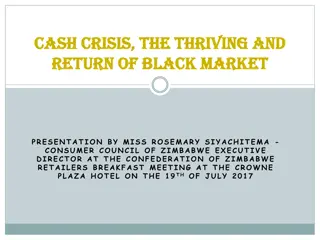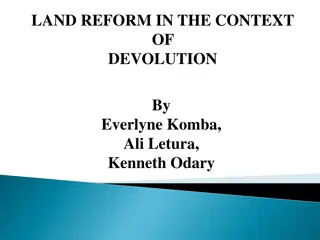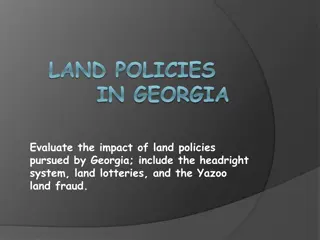Migration, Land Reform, and Resources Management in Zimbabwe
Study conducted in Chimanimani district of Zimbabwe examines the impact of land reform on migration patterns, livelihood strategies, and natural resource use. Different settlement models pre and post-independence are analyzed, highlighting changes in agricultural practices, forest resource utilization, and overall welfare of migrants.
Download Presentation

Please find below an Image/Link to download the presentation.
The content on the website is provided AS IS for your information and personal use only. It may not be sold, licensed, or shared on other websites without obtaining consent from the author. Download presentation by click this link. If you encounter any issues during the download, it is possible that the publisher has removed the file from their server.
E N D
Presentation Transcript
Land Land Reform Reform Migrations Resources Resources Management in Management in Zimbabwe Migrations and and Forest Forest Zimbabwe Prisca H. Mugabe, Krasposy Kujinga, Sunungurai D. Chingarande, Charity Nyelele, Esteri Magaisa, Pascal Sanginga Paper presented at Migration, Rural Livelihoods and Natural Resource Management Hotel Entre Pinos, San Ignacio, Chalatenango, February 21-24, 2011
Research Partners Chimanimani District farming communities (Nyabamba, Shinja, Chayamiti) University of Zimbabwe Institute of Environmental Studies (IES) Department of Sociology Department of Geography and Environmental Sciences Southern Alliance for Indigenous Resources (SAFIRE) Chimanimani District State Agencies Environment Management Agency Forestry Commission Chimanimani Rural District International Development Research Centre (IDRC) 2
Description of the territory Chimanimani district, Manicaland province, eastern Zimbabwe Three study sites representing a gradient of agrarian settlement models before and after national independence namely: Nyabamba, a Fast Track Land Reform Programme A1 model area; Shinja, a post-independence old resettlement area Chayamiti, a traditional communal area 3
Livelihood strategies Diversity of livelihood activities Crop production: most common, thus 88% of FTLRP migrants to Nyabamba immediately cleared forests in order to commence agricultural activities Maize (staple) sunflower, finger millet, sugar beans, wheat, groundnuts, round nuts, cowpeas and sweet potatoes Other livelihood activities: livestock production, gardening, piecework, well drilling, needlecrafts, vending, brick moulding, and beekeeping Nyabamba migrants claim their welfare generally improved as a result of the land reform migration 6
Natural resource use Harvesting of forest resources 80% households firewood, building poles, timber, herbs, grass, fruits, mushrooms, and meat household use or sale Almost all the households relied on firewood for cooking and heating 20% of the migrants involved in making secondary products from forest raw materials Nyabamba s forest resources endowement migrants false sense of perpetual abundance? Only 2% of the migrants see forest conservation responsibilities as their own 7
Gendered use of forests Women collection of firewood herbs and wild fruits 64% of firewood collecters were women Men construction poles and firewood for sale making processed forest products for sale or home use 8
Economic dynamics Nyabamba rural to rural migrations derives from colonial land occupation of Zimbabwe of late 1800s -1980 wherein: Indigenous people forcibly relocated to segregated native reserves coercively forced into labour on colonial settler farms forced rural to rural, rural to urban migration Native reserve lands: very restricted access to natural resources 75% of native reserves land was in the most arid and unfertile areas Severe overcrowding and land degradation Poverty in the native reserves was exacerbated by poor access to natural resources, legal, social and economic barriers created by the colonial government Communities used natural resources such as forests as safety nets against poverty 10
Environmental dynamics Nyabamba: > 1000 mm rainfall per annum, 18-26 0C in summer and 12-150C in winter Average : 750m above sea level > 80% of land is on steep terrain, susceptible to erosion and land degradation Ecoregion: montane forest-grassland mosaic (WWF, 2001) Patches of indigenous Miombo vegetation against a landscape of exotic pine and wattle plantations Choice of forests as the study natural resource domain: because of the abundance of natural and planted forests in Chimanimani, and the importance of forest resources Before FTLRP, most of the forests in the district had remained fairly intact due to inaccessible location and legal protection Threats to the forest resources due to resettlement: national implications due to wide range of timber and non-timber products Zimbabwe, forests contribute 3% of GDP and employ 8% of the total labour force in the manufacturing sector (Mabugu and Chitiga, 2002) 11
Institutional framework Formal institutions regulating use and management of forest resources State agencies: Chimanimani Rural District Council, Environmental Management Agency, Forestry Commission Minimal effectiveness due to constrained implementation capacity Traditional leadership: most important forest governance structure Thus, any efforts to improve the forest management practices in this area have to be centered around traditional leadership Local and traditional rules and regulations for forest resources use were in place in Nyabamba But, problematic enforcement High demand for the resources, e.g., wet wood for construction and brick curing, stream bank cultivation for gardening Implications for forest management interventions? 12
Agrarian reform regimes Zimbabwe initiated Fast Track Land Reform Programme (FTLRP) in 2000 after unsuccessful post-independence (1980) land resettlement programmes in response to socio-political pressures for faster land reforms fast track : spontaneously, very short period of time A1 and A2 resettlement models A1: villagized , individual residential and arable plots, communal grazing, woodlots, forests similar to traditional communal lands but larger plots aim: decongest communal lands, relieve land pressure in over-populated areas, extend and improve agriculture base in the peasant farming sector, official target: landless peasants predominantly rural to rural migration stipulated A1 land sizes inclusive of the communal grazing area: 12-70 hectares depending on rainfall FTLRP was implemented concurrently in all the provinces for socio-political equity 13
FTLRP process Farm invasions or jambanja : spotentaneous initial occupation of white owned commercial farms by black masses Official resettlement: using Government constitutional and legislative provisions Invaded farm demarcation and designation to individual settlers Offer letters: official recognition of settlers prior to official tenure Issuance of permits and leases 14
Local and traditional knowledge systems Local rules governed the preservation of sacred places in forests such as springs, mountains and rivers Not allowed to cut down trees, start fires, draw water from natural sources using metallic and modern objects, and bathe at sacred sites Sacred places importance: believed to be ancestral spirits residence sites for traditional spiritual ceremonials such as rainmaking ceremonies and rituals for appeasing the spirits. Violating rules and regulations regarding the preservation of sacred places: punishment by the headman there was belief that the ancestral spirits would also punish violaters Consequently, these areas were relatively intact 15
Conceptual framework Adapted Hugo s model (1996): environmentally induced migration shaped by predisposing conditions; precipitating events; constraining and facilitating factors; migration process, natural resource management and the policy response Predisposing conditions, e.g., forest degradation, soil fertility depletion e.g., In Zimbabwe communal areas resultant pressure on natural resources predisposes people to migration A1 migrations mainly precipitated by prevailing national political and legislative environment A1: impelled not forced migration, migrants retain some power to decide to migrate But different from voluntary migration where migration is entirely migrant s decision A1 resettlement process: combination of complex multiple pressures Policy and legislative arrangements by government precipitated mass migrations Further policy provisions and refinements were made to aid the FTLRP after the migrations 17
Research hypotheses Forest resources are important pull factors for migration into Chimanimani A1 resettlement areas. Access to forest resources is gender and poverty related among Chimanimani A1 migrants. Management of forest resources in Chimanimani A1 resettlement areas can be enhanced through improved local institutions and improved local capacity for forest management. 18
Natural resource management Major concern : possible environmental degradation due to the influx of settlers to the resettlement areas A1 settlers were drawn mostly from various communal areas, urban areas, growth points and mining areas, creating a cosmopolitan mixture of settlers, mixed bag of A1 settler migrants had different experiences in institutionalised forest resource management This scenario is expected to result in disintegrated natural resource management strategies and institutions whose effects on natural resource integrity could be detrimental Most A1 migrants engage in non-agricultural livelihood strategies such as sale of fuel wood (Presidential Land Review Committee, 2003) which may result in overharvesting of trees in the forests Requisite sharing of forests resources by immigrants in A1 resettlement areas could re- create some of the problems experienced in communal areas where the commonly shared land resources are often over-utilized and degraded 19
Lessons: migration Most important pull factor: agricultural land Rejects research hypothesis that forest resources were the important pull factors 90% of the pull factors were directly related to the land better farm land, opportunity to own land less populated area 21
Lessons: forest management Forests were invaded and cleared for agricultural activities but there remained forest patches that provide a number of forest products and services 86% of the Nyabamba migrants had to clear the forest in order for them to commence farming 1-3 months to clear land for farming and residential Over 70% reduction in forest cover of the area Outside intervention should not be merely to stop deforestation but to facilitate change of attitudes about forests 22
Lessons: gender Women: majority land invasion participants Offer letters: 69.2% only men s 7.7% both the husband and wife s names 14.4% only the wife s name Did FTLRP advance women s empowerment causes? 25
Lessons: capacity building Nyabamba migrants not oblivious to the degradation of their forests Formulated community action plans Benefited from NRM capacity building legislation awareness workshop, formed Environmental Management Committees, afforesation, sustainable bee keeping 26
Forest resources management This... This... ....Instead of this ....Instead of this 27
Future scenarios Disparity in the access to resettlement land between men and women This could accentuate poverty amoung the vulnerable gender groupings where agriculture is key livelihood Gender disparities defeat FTLRP objectives of improving the livelihoods of migrants Policy implication for the governance of forest resources is that there should be efforts to strengthen the traditional institutions which seem to be the more recognized. A strong partnership of farmer communities, traditional institutions, government, non- governmental organizations, commercial timber producers and the Rural District Council should be supported by institutional and technical capacity building of communities. Importance of provision of institutional capacity building for NRM in resettlement programmes. e.g., Environment Management Committees , local by-laws Role of collaborative research 28
Thank you Muchas Gracias 30























